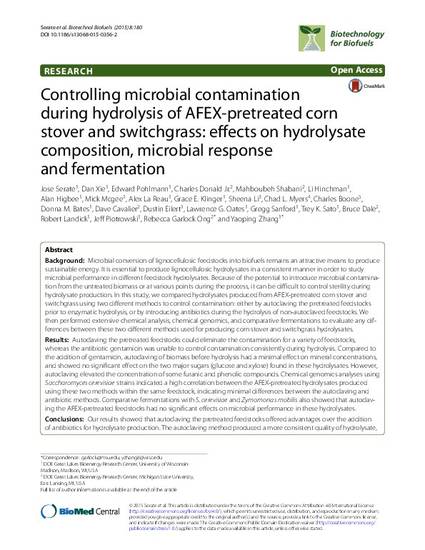
Article
Controlling microbial contamination during hydrolysis of AFEX-pretreated corn stover and switchgrass: effects on hydrolysate composition, microbial response and fermentation
Biotechnology for Biofuels
(2015)
Abstract
Background
Microbial conversion of lignocellulosic feedstocks into biofuels remains an attractive means to produce sustainable energy. It is essential to produce lignocellulosic hydrolysates in a consistent manner in order to study microbial performance in different feedstock hydrolysates. Because of the potential to introduce microbial contamination from the untreated biomass or at various points during the process, it can be difficult to control sterility during hydrolysate production. In this study, we compared hydrolysates produced from AFEX-pretreated corn stover and switchgrass using two different methods to control contamination: either by autoclaving the pretreated feedstocks prior to enzymatic hydrolysis, or by introducing antibiotics during the hydrolysis of non-autoclaved feedstocks. We then performed extensive chemical analysis, chemical genomics, and comparative fermentations to evaluate any differences between these two different methods used for producing corn stover and switchgrass hydrolysates.
Results
Autoclaving the pretreated feedstocks could eliminate the contamination for a variety of feedstocks, whereas the antibiotic gentamicin was unable to control contamination consistently during hydrolysis. Compared to the addition of gentamicin, autoclaving of biomass before hydrolysis had a minimal effect on mineral concentrations, and showed no significant effect on the two major sugars (glucose and xylose) found in these hydrolysates. However, autoclaving elevated the concentration of some furanic and phenolic compounds. Chemical genomics analyses using Saccharomyces cerevisiae strains indicated a high correlation between the AFEX-pretreated hydrolysates produced using these two methods within the same feedstock, indicating minimal differences between the autoclaving and antibiotic methods. Comparative fermentations with S. cerevisiae and Zymomonas mobilis also showed that autoclaving the AFEX-pretreated feedstocks had no significant effects on microbial performance in these hydrolysates.
Conclusions
Our results showed that autoclaving the pretreated feedstocks offered advantages over the addition of antibiotics for hydrolysate production. The autoclaving method produced a more consistent quality of hydrolysate, and also showed negligible effects on microbial performance. Although the levels of some of the lignocellulose degradation inhibitors were elevated by autoclaving the feedstocks prior to enzymatic hydrolysis, no significant effects on cell growth, sugar utilization, or ethanol production were seen during bacterial or yeast fermentations in hydrolysates produced using the two different methods.
Keywords
- Biomass feedstock,
- Lignocellulosic hydrolysate,
- Fermentation,
- Chemical genomics,
- Inhibitors,
- Sterility,
- Saccharomyces cerevisiae,
- Zymomonas mobilis
Disciplines
Publication Date
November 14, 2015
DOI
http://dx.doi.org/10.1186/s13068-015-0356-2
Publisher Statement
© Serate et al. 2015. Publisher's version of record deposited here in compliance with publisher policies.
Citation Information
Jose Serate, Dan Xie, Edward Pohlmann, Charles Donald, et al.. "Controlling microbial contamination during hydrolysis of AFEX-pretreated corn stover and switchgrass: effects on hydrolysate composition, microbial response and fermentation" Biotechnology for Biofuels (2015) ISSN: 1754-6834 Available at: http://works.bepress.com/rebecca-ong/2/
Creative Commons license

This work is licensed under a Creative Commons CC_BY International License.
